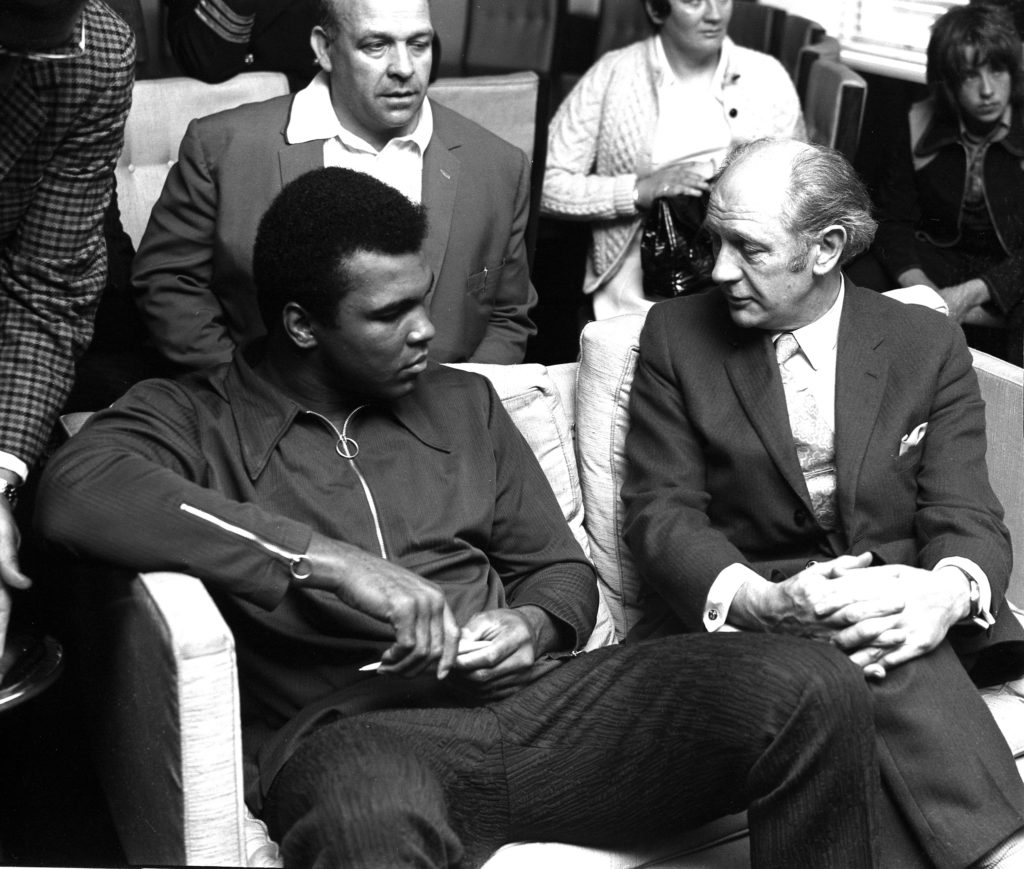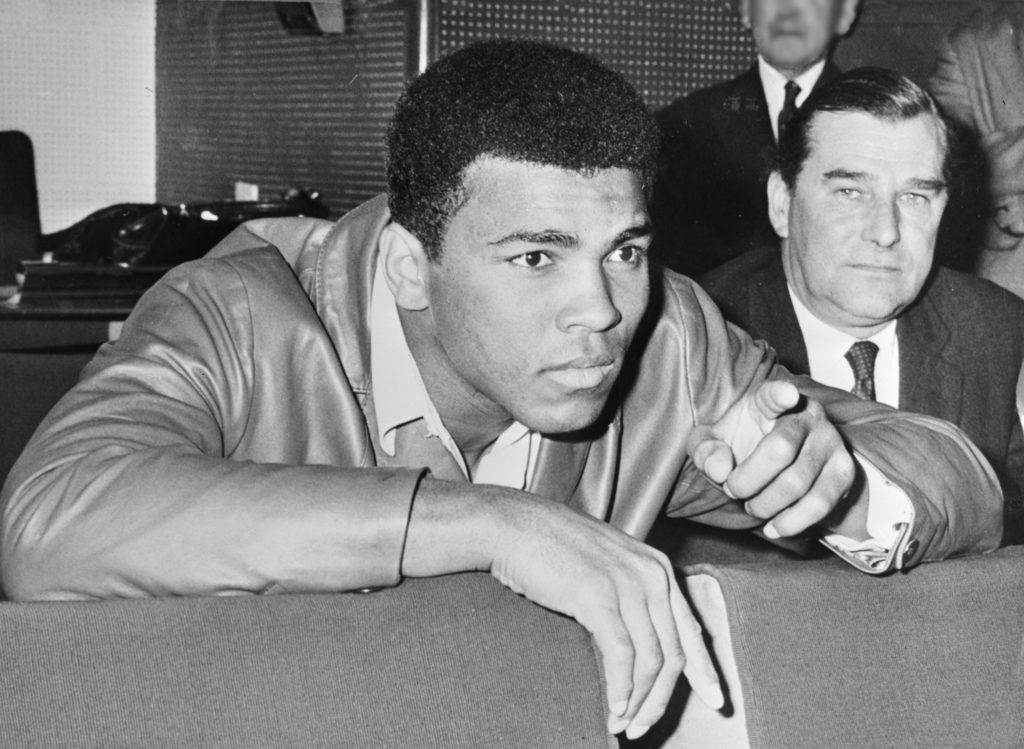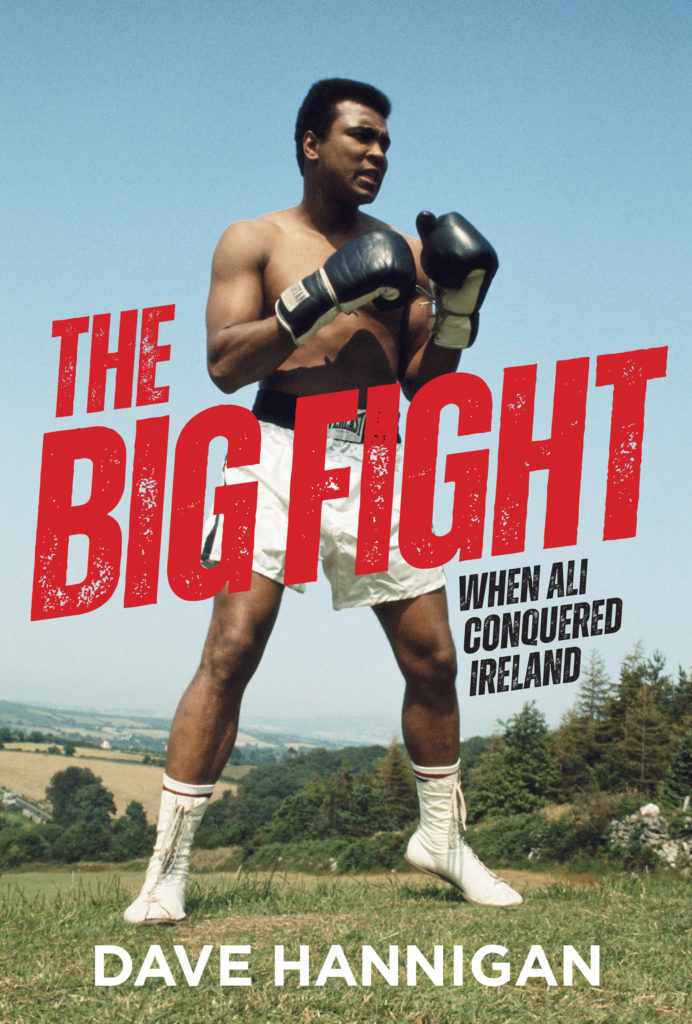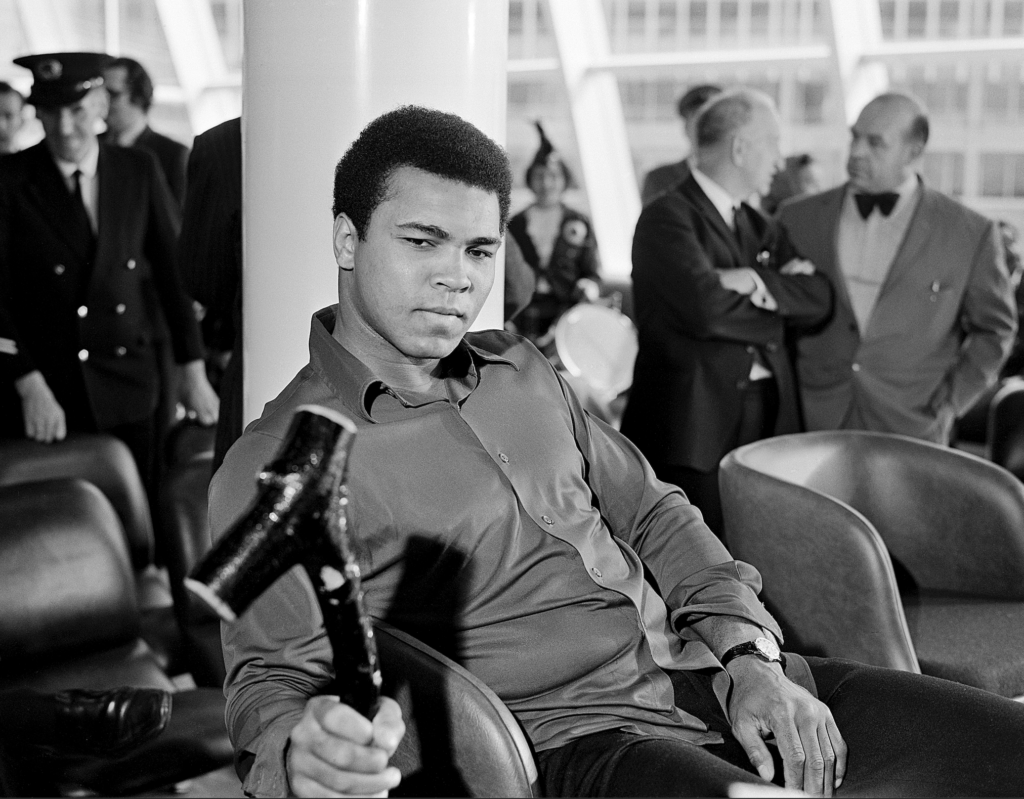ON A balmy July evening in 1972, to the sound of The Dubliners, Muhammad Ali climbed through the ropes to fight Al ‘Blue’ Lewis at Croke Park.
The most famous athlete in the world had somehow been inveigled to come to Ireland by Butty Sugrue.
Ali defeated Lewis in a technical knock-out in round 11.
Prior to the visit, the charismatic London-based publican and entrepreneur was ridiculed for trying to do the impossible — right up to the moment Ali and his entourage touched down at Dublin Airport.
And so began a week of the most glorious mayhem, as ‘the Champ’ charmed the Irish people.
Ali could be found jogging along Wicklow lanes, strolling into The Old Stand pub, chatting with street cleaners, and paying an early morning visit to the GPO to receive a history lesson about the Easter Rising.
No matter where he fetched up, wonderful chaos ensued. Traffic stopped. Crowds gathered. The greatest show on earth had come to town.
 Muhammad Ali with Taoiseach Jack Lynch
Muhammad Ali with Taoiseach Jack LynchThe background to the visit
ON A tour of England in October, 1971, Muhammad Ali visited The Wellington, Butty Sugrue’s pub in Shepherd’s Bush, London. At one point in the festivities, the Kerryman and Ali had a one-on-one chat during which the landlord asked the former heavyweight champion of the world to consider a fight in Ireland, the profits from which would go to a charity close to his heart.
“Like Joe Louis, he is deeply interested in the welfare of the mentally handicapped,” Sugrue said. “So, I put the idea to him and asked him would he fight in Dublin.
He told me he would go anywhere at any time to fight for the mentally handicapped children. And he promised me then to do this fight for £100,000.”
Whether Ali made any personal assurances about a future bout for any charity is open to question but there is no doubt the idea of him boxing in Ireland seems to have been born during that encounter.
Not that this kind of forensic detail mattered to the sceptical media in Ireland.
They were not convinced by Sugrue’s announcement in March 1972 that the most famous athlete in the world would be coming to Dublin that summer. As if a former circus strongman could pull off such a feat...
 Muhammad Ali pictured in 1966
Muhammad Ali pictured in 1966Butty backs it up
A MASTER at garnering publicity, Butty Sugrue was forever dreaming up madcap ventures designed to drive up revenue at his establishments. Barely four years had passed since he had last made international headlines. In his second attempt at a specific world record, he persuaded Mick Meaney, a Tipperary-born barman at the Admiral Nelson —a pub he then ran in north London—to spend sixty-one days in a coffin, buried eleven feet below the surface.
Meaney was placed in his ‘all-mod cons’ coffin.
Before the burial, Sugrue organised ‘The Last Supper’, a meal at which Jack Doyle, one-time heavyweight contender turned cabaret act, sang songs.
Watched by a large crowd wearing solemn black suits and gleaming white shirts, he was passed through the window of the bar and lifted onto a flatbed truck cum hearse that took him to his ‘final’ resting place at Mick Keane’s building yard. When Meaney finally emerged from his subterranean resting place more than two months later, it was to a kiss from the glamorous figure of Diana Dors, and the sound of a pipe band.
Questions were subsequently raised about the nature of that enterprise in the House of Commons, a measure of how well Sugrue sold the stunt to the media and how famous he had become in Britain.
It was all a long way, literally and metaphorically, from Gortnascarry, the townland near Killorglin in south-west Kerry where Michael (his official name) was born on 24 July 1924.
In his youth, he had been an amateur boxer at a time when budding Killorglin fighters fought in a ring set up in the fabled Oisin Ballroom on Iveragh Road. Alongside his brother Tim, known to all as ‘Fly’, he also travelled to compete at tournaments in Cahirciveen, Tralee and Castleisland. Around then he started to gain a reputation for being abnormally strong. Popular lore in the area held that his power was down to the amount of goat’s milk he drank in his formative years. English newspapers, prompted by his own anecdotes, later attributed his brawn to an idyllic rural childhood spent chasing wild rabbits and eating them raw.
He spent much of the 1940s and early 1950s traversing the country as a headline act with Duffy’s Circus.
Most evenings, he entered the ring to the sound of his colleague Michael Doyle playing the accordion, the audience gasping the instant they realised the musician was perched atop a chair which Sugrue held between his teeth while walking along.
Posters declared him ‘Ireland’s Strongest Man!’ Those who disagreed were invited into the spotlight to see if they could match his feats. Usually, he lifted four fifty-six-pound shop weights attached to a steel cart axle (also fifty-six pounds) above his head and then watched the doubters and naysayers fail one by one to replicate his action.
Another trick was to sit ten men on a trailer before dragging it around the big top with a rope clenched between his teeth.
Typical sideshow fare, the kind of act that the people of a town remembered, and it made Sugrue nationally famous. When the adults repaired to the pubs afterwards, they spent hours figuring out how such a small man could be so strong. At school the next day, kids talked of little else. Over time, his legend grew and grew and the story about him tugging a double-decker bus across O’Connell Bridge in Dublin with those ever-resilient gnashers became national lore.
 The Big Fight by Dave Hannigan is now available
The Big Fight by Dave Hannigan is now availableThe London entrepreneur
Emigrating to London in the early 1960s, Sugrue arrived in a city teeming with Irish and opportunity. A teetotaller, he got involved in the pub business, an industry where his name recognition and flair for promotion brought exiled compatriots flocking to his bars.
If his quiet manner and gentle ways belied his illustrious past as Ireland’s strongest man, customers caught glimpses now and then of his remarkable abilities.
Troublemakers left his establishments in a hurry. He wouldn’t fight anybody, he’d just grab at them, and once he’d gained a substantial hold, the miscreant was bodily lifted from the premises and warned not to return.
Not long after Nelson’s Pillar was blown up on O’Connell Street in Dublin in 1966, Sugrue put the word out that the head of the statue would be making an appearance in the Admiral Nelson in London on a certain night.
The place was packed to the rafters when the proprietor announced that, unfortunately, some ne’er-do-wells had stolen the head from a wheelbarrow in the backyard the previous evening. Only Sugrue could get away with disappointing people on that scale.
For all these misadventures, stunts, and half-truths, Sugrue’s friends regarded him as intensely loyal, and he had an admirable history of assisting Irish people in London, most especially Jack Doyle, an increasingly pathetic alcoholic.
If the Corkman needed a place to stay, he knew his Kerry pal would come through for him.
Once, he accompanied the former contender to Elstree Studios for a summit with Marlon Brando, who had sent his Rolls Royce to ferry them to the set of The Countess of Hong Kong.
Both men had been married to Movita, a Mexican film star, and Brando wanted information from Doyle to help him negotiate his divorce.
Sugrue tagged along as security in case the discussion between the ex-husband and the wannabe ex-husband turned ugly. It didn’t.
The trio got on so well that Sophia Loren stood in for a photograph with them that day.
For the rest of the decade, Sugrue became such a staple in London tabloids that one columnist affectionately dubbed him ‘the splendid spoofer’.
Photographs of somebody sitting on a chair that he was clasping in his teeth or shots of him grimacing while holding back a revving motorcycle (a stunt he enacted on the ‘Tonight with Dave Allen’ television show) were regular features in the English press.
Yet, the showbiz persona was very different from his private self. Noted for his charity and generosity to those struggling, he once performed his strongman act for the delighted inmates of Maidstone Prison.
In 1970, he pulled together a star-studded evening at the Royal Albert Hall in aid of ‘the National Society for Mentally Handicapped Children and St. Patrick’s Island.’
With the Irish tenor Josef Locke as the headliner, support acts included The Johnstons (featuring Paul Brady), the New Faces, and an up-and-coming singer called David Bowie, strumming a 12-string, and singing Space Oddity. Quite the line-up.
Wanting to help kids was a typically noble project of his but the St. Patrick’s Island aspect of the fund-raising was more dubious. The previous year, in a supposed move to stop it being taken over by hippies, he had purchased this tiny islet off the coast of north Dublin.
 Muhammad Ali puzzles over a shillelagh gifted to him by Timothy ‘Chub’ O’Connor TD
Muhammad Ali puzzles over a shillelagh gifted to him by Timothy ‘Chub’ O’Connor TDHe wanted to build a spiritual and health retreat facility there, a place where ‘slim men will grow big and big men will grow slim’.
There may have been truth to that intention but, not long after the announcement, Mick Jagger had to deny newspaper reports he had bought the 16 acres located 1.5km from the mainland off the Kerryman.
“I’m not in the business of buying islands,” said Jagger. “What’s more, I have never heard of Mr. Sugrue.”
That would have made the Rolling Stone unique because Sugrue was an extraordinarily adept self-publicist and stories about him were legion.
He once challenged the combined Oxford-Cambridge boat race crews to a tug of war. They demurred. He regularly called out publicans around the world, offering them £500, sometimes doubling that sum, if they came to London and matched his feats of strength. None ever took him up on the offer
This then was the picaresque character purporting to bring Muhammad Ali to Ireland and many of the country’s sportswriters just could not reconcile his chequered history of bizarre exploits with his present lofty intentions.
Yes, Sugrue had succeeded in bringing Joe Louis on a tour of Ireland in 1966, as a cabaret act, not a fighter, and inevitably bragged he had lifted the former heavyweight champion in a chair clean off the ground with his teeth. But that promotion lost money and turned into a farce.
And, while getting a superannuated boxer decades removed from his pomp to sing at The Arch Ballroom in Tallow, West Waterford was a singular achievement, it was not the same as trying to import the most box-office athlete on earth to fight.
Particularly against the backdrop of some of the worst violence in Northern Ireland and in the year in which the Scottish and Welsh rugby teams refused to travel to Dublin for safety reasons.
Surely Butty was not seriously going to try to bring Muhammad Ali to Ireland . . . .
The Big Fight - When Ali Conquered Ireland, by Dave Hannigan, Published by the O’Brien Press, costs.€12.99.

